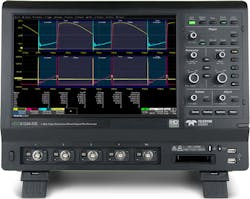Air Force asks industry for real-time oscilloscope to detect and analyze electromagnetic warfare signals
WRIGHT-PATTERSON AFB, Ohio – U.S. Air Force electromagnetic warfare experts are surveying industry to find companies able to provide a real-time oscilloscope to detect and evaluate electromagnetic threats.
Officials of the Air Force Research Laboratory (AFRL) at Wright-Patterson Air Force Base issued a sources-sought notice on Wednesday (SS-AFRL-PZLEQ-2022-0011) for the Real-Time Oscilloscope project.
This test instrument must offer bandwidth of at least 50 GHz; data acquisition rate per channel of at least 256 gigasamples per second; four independent channels; configurable millimeter-wave extension window of less than or equal to 10 GHz; DDC bandwidth of at least 2 GHz; ability to provide vector signal analysis and pulse signal analysis; onboard memory of at least 5 gigapoints per channel; ability to provide de-embedding; and five-year warranty.
The oscilloscope must support software modules and a specialty transit case with pulse signal analysis and vector signal analysis capability.
Related: Test and measurement equipment keeps high-tech systems in working order
Electromagnetic warfare uses aimed electrical and magnetic energy to destroy or disable critical enemy electronics for navigation and guidance, computing, communications, displays, timing, sensors, and many other military applications. Typical electromagnetic weapons use high-power microwaves.
Experts have determined they can mitigate many new electromagnetic threats by moving to ultra-short pulse lengths. This presents the need to characterize these ultra-fast pulses with a high degree of sampling fidelity, Air Force experts say.
Data acquisition rate capabilities over the past decade, however, have limited data fidelity. The threshold for measuring these ultra-fast rise time events requires a sampling rate that has become commercially available.
Previous efforts have relied on the perfect reproduction of the threat pulse for several times and then sampling several pulses and interpolating the data to enable Air Force researchers to measure a single pulse directly and not rely on reproducing an ultra-short pulse for 10 times, which is not able to be verified.
Related: Measuring radar PRI stagger during walkoff
This will help researchers measure the threat pulse and resulting performance simultaneously over the oscilloscope's four ports. This would represent a unique cutting-edge capability for the Air Force Research Laboratory, experts say.
Companies interested should email responses to the Air Force's Jacob Britt no later than Wednesday, 5 Oct. 2022 at [email protected], with “Real-Time Oscilloscope Requirement” in the subject line.
Attachments of .zip or .exe files are not allowed. Those responding may attach .PDF, .doc, docx, xls, or .xsls documents. E-mail filters may delete any other form of attachments.
Email questions or concerns to [email protected], with “Real-Time Oscilloscope Requirement” in the subject line. More information is online at https://sam.gov/opp/c59ebe75203e411b8e27807b3113775c/view.
About the Author
John Keller
Editor-in-Chief
John Keller is the Editor-in-Chief, Military & Aerospace Electronics Magazine--provides extensive coverage and analysis of enabling electronics and optoelectronic technologies in military, space and commercial aviation applications. John has been a member of the Military & Aerospace Electronics staff since 1989 and chief editor since 1995.
